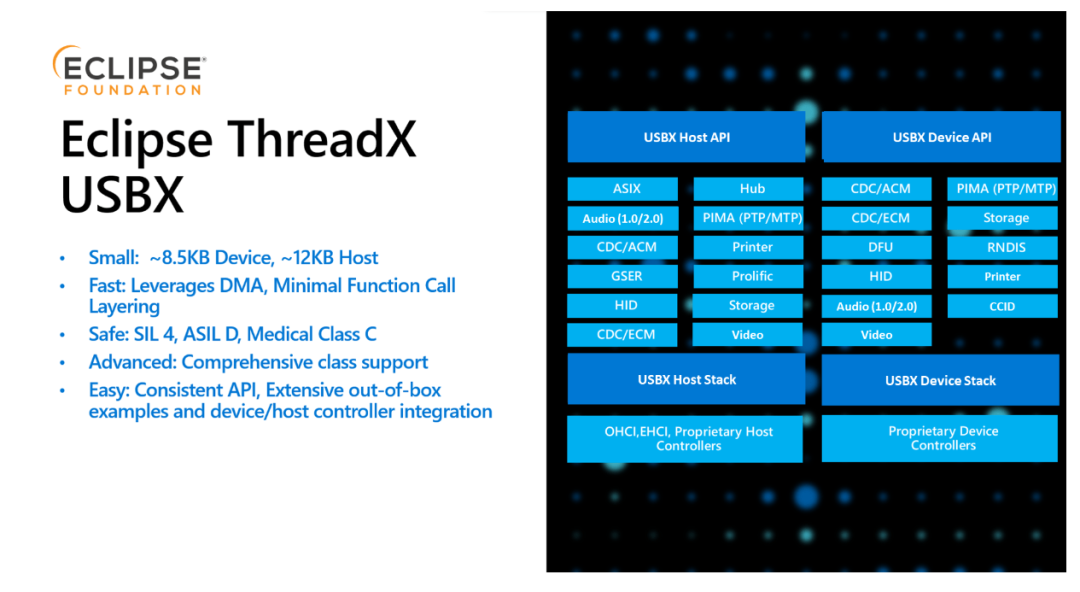USB has become an indispensable interface in modern embedded systems, and choosing the right USB stack is crucial for project success. Eclipse ThreadX USBX, with its high performance, low resource consumption, and ease of use, has become the preferred choice for many embedded developers.
1. Overview of Eclipse ThreadX USBX: An Efficient and Reliable Embedded USB Solution
Eclipse ThreadX USBX is a powerful embedded USB stack that supports three modes: USB Host, Device, and On-The-Go (OTG). It is deeply integrated with the Eclipse ThreadX Real-Time Operating System (RTOS), fully leveraging ThreadX’s advantages in real-time performance, determinism, and resource efficiency. The streamlined design of USBX allows it to run on resource-constrained microcontrollers while ensuring high-performance data transfer and stability.

2. Architectural Design: Modular and Scalable Protocol Stack
USBX adopts a modular design, with its core components including:
-
• USB Host Controller: Manages devices connected to the USB host port, such as mice, keyboards, storage devices, etc. It provides a unified interface, allowing applications to operate without concern for underlying hardware details. -
• USB Device Controller: Allows embedded systems to communicate as USB devices with hosts, such as USB storage devices, sensors, or other peripherals. It handles various USB protocol requests and data transfers on the device side. -
• USB OTG Controller: Supports switching between USB host and device modes, allowing the device to act as a host or device when needed. -
• Drivers: Provide corresponding drivers for various USB devices, enabling access and control of different types of devices. -
• Configuration and Management Module: Allows users to customize the behavior of USBX, such as setting transfer rates, interrupt handling, and power management.
This modular design gives USBX good scalability and flexibility, allowing easy customization based on specific application needs. Furthermore, its clear code structure facilitates debugging and maintenance for developers.
3. Usage: Easy Integration and Quick Start
The integration and use of USBX are very convenient. It is typically provided as a static library, which can be added to the project’s build system. Developers can customize USBX’s behavior through the configuration and management module and use the provided API functions to access and control USB devices.
USBX offers a wealth of example code covering various application scenarios, such as USB mice, keyboards, storage devices, and custom USB devices. These example codes help developers quickly understand how to use USBX and apply it to their projects.
4. Key Features and Advantages:
-
• Multi-Platform Support: USBX supports various microcontroller architectures and compilers, including ARM Cortex-M and RISC-V, greatly enhancing project flexibility. -
• Low Resource Consumption: Optimized code and efficient memory management mechanisms allow USBX to run on resource-constrained embedded systems. -
• High-Performance Data Transfer: USBX optimizes data transfer to ensure efficient data transmission speeds under various conditions. -
• Easy to Debug: Clear code structure and detailed documentation make it easy for developers to debug and troubleshoot issues. -
• Seamless Integration with ThreadX RTOS: The tight integration with ThreadX RTOS simplifies system development and debugging, improving development efficiency.
5. Real-World Application Cases: IoT, Industrial Control, and More
USBX plays an important role in various embedded applications, such as:
-
• Internet of Things (IoT) Devices: USB interfaces can be used to connect various sensors, actuators, and other peripherals for data acquisition and remote control. -
• Industrial Control Systems: USB interfaces can connect PLCs, sensors, actuators, etc., to achieve industrial automation control. -
• Medical Devices: USB interfaces can connect various medical sensors and devices for data acquisition and remote diagnosis. -
• Consumer Electronics: USB interfaces can connect various peripherals to enhance user experience.
6. Conclusion
As IoT and embedded system technologies continue to evolve, the importance of USB interfaces is becoming increasingly prominent. Eclipse ThreadX USBX, with its efficient, reliable, and user-friendly features, will continue to play a significant role in the embedded USB domain.
Project Address: https://github.com/eclipse-threadx/usbx